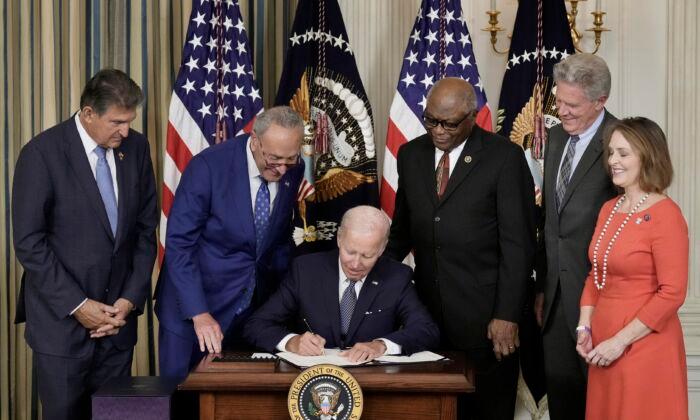Its sponsors aim to pay for all this by upping corporate taxes and using stepped-up IRS enforcement to collect more money from everyone.
The law will increase federal outlays by roughly $435 billion over the next five years. Its sponsors claim that the budget deficit will shrink because the law’s new taxes and enforcement efforts will raise government revenues more than enough to offset the additional spending.
Green initiatives take the bulk of the legislation’s outlays—$385 billion over the next five years. The law offers generous tax benefits and $40 billion in loan guarantees to promote carbon capture and “clean hydrogen” at electric facilities (regardless of energy source). It also offers tax credits and loan guarantees for nuclear power production and clean vehicles of all sorts. This support will extend to projects for advanced manufacturing, biogas, fuel cells, and energy storage technologies, including carbon capture and sequestration. Some $2 billion in direct loans will go to constructing and modifying electric transmission facilities.
The law allows the transfer of credits to unrelated parties, but only under certain circumstances. It also repeals the Trump-era moratorium on offshore wind leases.

The IRA also aims to reduce greenhouse emissions by 40 percent by 2030. The effort gives the Department of Energy the authority to advance an array of grants, rebates, direct loans, and cooperative agreements to pay for up to half the costs of promising projects. Some would aim to improve the efficiency of household heating and cooling systems and appliances, with $1 billion earmarked for “affordable housing.” Some $60 billion would go to what the legislation refers to as “environmental justice initiatives” through which it would aim to provide benefits to previously underserved neighborhoods.
The legislation also allocates $27 billion to the Environmental Protection Agency and more to the Agriculture Department to provide financial and technical support for projects that promise to reduce greenhouse gas emissions. Automakers will get $6 billion to produce hybrid and plug-in electric vehicles in the United States.
A striving for centralized control runs throughout this legislation. It gives the heads of all the agencies involved considerable discretion on what activities can qualify for support and how they would qualify. In other words, Washington would direct the emphasis not only on production, but also on the way people and businesses can pursue it.
Against this quest for government command and control, complexity and expense, practical people would naturally look for something simpler, less intrusive, and perhaps more effective. A carbon tax would do that. By making the emission of greenhouse gases expensive, such a tax would unleash a great diversity of effort to limit the use of fuel and the release of such emissions. Every American would seek ways to reduce his or her carbon footprint. Instead of the IRA’s list of preferred technologies and what are effective commands on how to use them, this kind of general effort would engage everyone’s imagination. It would also proceed with more vigor than the IRA’s dictates could possibly muster.





